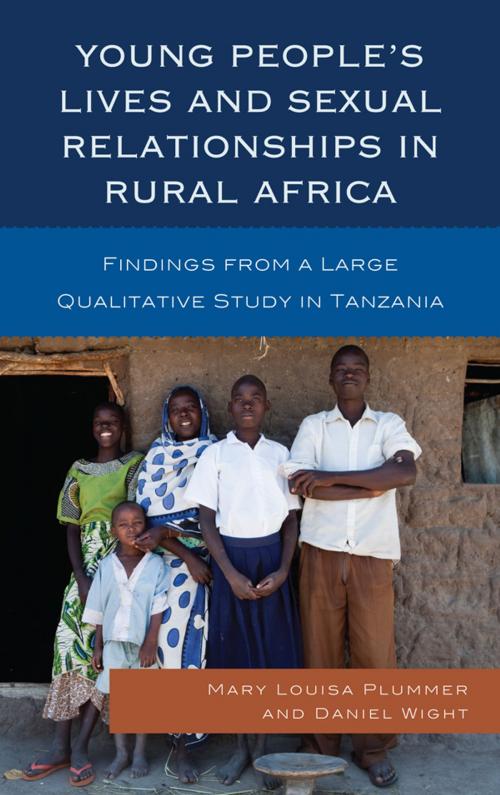Young People's Lives and Sexual Relationships in Rural Africa
Findings from a Large Qualitative Study in Tanzania
Nonfiction, Health & Well Being, Health, Ailments & Diseases, AIDs & HIV, Social & Cultural Studies, Social Science| Author: | Mary Louisa Plummer, Daniel Wight | ISBN: | 9780739135808 |
| Publisher: | Lexington Books | Publication: | August 16, 2011 |
| Imprint: | Lexington Books | Language: | English |
| Author: | Mary Louisa Plummer, Daniel Wight |
| ISBN: | 9780739135808 |
| Publisher: | Lexington Books |
| Publication: | August 16, 2011 |
| Imprint: | Lexington Books |
| Language: | English |
This book examines young African's sexual relationships in the context of village life. It is based on a large in-depth qualitative study in Tanzania, in a region typical of rural sub-Saharan Africa. It describes how dominant community values both discouraged and encouraged adolescent sexual activity. Young people managed these contradictions by concealing their sexual activity, contributing to short-term and/or overlapping relationships. Most adolescents had sex by age 15, but girls were often 5-10 years younger than their partners, and their relationships typically involved more frequent sexual encounters than those of same-aged boys. Motivations to have sex are examined, particularly its importance to masculine identity and its role in meeting young women's basic material needs, such as soap or respectable clothing. By their late teens most young people had experienced three types of sexual relationship: one-time sexual encounters; open-ended relationships involving occasional encounters; and 'main' semi-public partnerships involving frequent sexual contact. Relationships could involve desire, possessiveness, and affection, but romantic idealization of a partner was rare. Many young people expected their partners to be monogamous, but themselves had had concurrent relationships by age 20. Women generally married by age 20 and men by 25, with couples often having met about one month earlier. Marital couples usually spent little time together, and emotional intimacy was not highly valued. About one-third of marriages involved one husband and multiple wives. Extramarital sex, separation and divorce were fairly common. This book details factors shaping young people's sexual health, including access to, and beliefs about, condoms and other contraception. Condoms were rarely used because they were associated with reduced pleasure, infection and promiscuity. Sexually transmitted infections were fairly common, but several factors hindered young people from seeking biomedical treatment for them. Many instead relied on traditional medicine, as they did for contraception, induced abortion, and fertility promotion. Understanding of the biology of HIV/AIDS was very limited, and people with AIDS were sometimes believed to be bewitched with a non-infectious, curable illness. The book concludes by identifying key economic and cultural barriers to reducing sexual risk behavior, as well as factors that potentially facilitate risk reduction.
This book examines young African's sexual relationships in the context of village life. It is based on a large in-depth qualitative study in Tanzania, in a region typical of rural sub-Saharan Africa. It describes how dominant community values both discouraged and encouraged adolescent sexual activity. Young people managed these contradictions by concealing their sexual activity, contributing to short-term and/or overlapping relationships. Most adolescents had sex by age 15, but girls were often 5-10 years younger than their partners, and their relationships typically involved more frequent sexual encounters than those of same-aged boys. Motivations to have sex are examined, particularly its importance to masculine identity and its role in meeting young women's basic material needs, such as soap or respectable clothing. By their late teens most young people had experienced three types of sexual relationship: one-time sexual encounters; open-ended relationships involving occasional encounters; and 'main' semi-public partnerships involving frequent sexual contact. Relationships could involve desire, possessiveness, and affection, but romantic idealization of a partner was rare. Many young people expected their partners to be monogamous, but themselves had had concurrent relationships by age 20. Women generally married by age 20 and men by 25, with couples often having met about one month earlier. Marital couples usually spent little time together, and emotional intimacy was not highly valued. About one-third of marriages involved one husband and multiple wives. Extramarital sex, separation and divorce were fairly common. This book details factors shaping young people's sexual health, including access to, and beliefs about, condoms and other contraception. Condoms were rarely used because they were associated with reduced pleasure, infection and promiscuity. Sexually transmitted infections were fairly common, but several factors hindered young people from seeking biomedical treatment for them. Many instead relied on traditional medicine, as they did for contraception, induced abortion, and fertility promotion. Understanding of the biology of HIV/AIDS was very limited, and people with AIDS were sometimes believed to be bewitched with a non-infectious, curable illness. The book concludes by identifying key economic and cultural barriers to reducing sexual risk behavior, as well as factors that potentially facilitate risk reduction.















